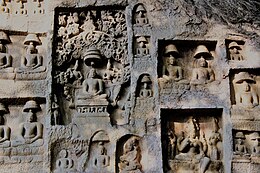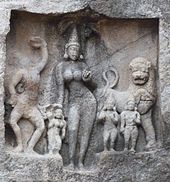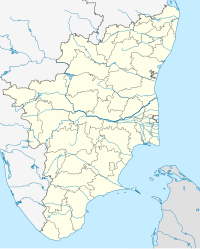| Kalugumalai Jain Beds | |
|---|---|
 Kalugumalai Jain Beds | |
| Religion | |
| Affiliation | Jainism |
| Location | |
| Location | Kalugumalai, Thoothukudi, Tamil Nadu |
Location in Tamil Nadu | |
| Geographic coordinates | 9°09′02″N 77°42′15″E / 9.15056°N 77.70417°E |
| Architecture | |
| Style | Pandyan |
| Creator | King Parantaka Nedunjadaiya |
| Date established | 8th century |
| Materials | Rock cut |
| Website | |
| kalugumalaitemple | |
Kalugumalai Jain beds in Kalugumalai, a panchayat town in Thoothukudi district in the South Indian state of Tamil Nadu, are dedicated to the Jain religious figures. Constructed in rock cut architecture, the unfinished temple is believed to have been built during the reign of Pandyan king Parantaka Nedunjadaiya (768-800 CE). The rock-cut architecture at Kalugumalai is an exemplary specimen of Pandyan art. The other portions of Kalugumalai houses the 8th century unfinished Shiva temple, Vettuvan Koil and Kalugasalamoorthy Temple, a Murugan temple at the foothills.
There are approximately 150 niches in the bed, that includes images of Gomateshwara, Parshvanatha and other Tirthankaras of the Jainism. The Jain beds are maintained and administered by Department of Archaeology of the Government of Tamil Nadu as a protected monument.
History
[edit]The earliest Kalugumalai Jain Beds are dated to the 8th century based on palaeographic and literary evidence, during the reign of Pandya king Parantaka Nedunjadaiya (768-800 CE).[1]
According to Paul Dundas – a scholar on Jainism studies and Sanskrit, the Kalugumalai is one of the oldest Jain sites in South India. He dates the earliest excavations and inscriptions to about 8th-century CE. All reliefs and inscriptions at Kalugumalai were complete by the late 1st-millennium, while Jainism thrived in this region till about the 14th-century.[2] Like other South Indian Jain historic sites, this was also a Digambara tradition site. However, states Dundas, the word Kalugumalai means "Vulture peak" reminiscent of the legendary site in north India attributed to the Buddha for his sermons.[2] The local traditions connect the history of this stone hillock with early but extinct Buddhism. Perhaps, the hillock was once related to Buddhism, was abandoned and later Jains and Hindus reused the site for their own monasteries and temples.[2] Around the Jain beds hillock are several old Hindu temples from the early Pandya era who also sponsored the Jain beds. These include one for Shiva, one for Murugan, and another for Aiyanar. In the local tradition, states Dundas, the Hindu god Aiyanar is believed to be the guardian deity for Jain temples. During modern times, some Digambara monks attempted replacing the idol of Murugan in the lower cave temple with that of Mahavira, leading to religious disturbances.[2]

There are 98 inscriptions related to Jainism at the Kalugumalai Jain Beds site, the largest known concentration of Jain inscriptions in far south India at a single site.[3] These are found below the reliefs of Tirthankaras and yakshis, as well as near the hollowed out beds. Most are records of donors and gifts.[3] Some contain information and names of mendicants, both men and women. Of the 98, 21 inscriptions (20%) in Kalugumalai mention women mendicants. This is in contrast to 8th to 13th-century Jain inscriptions found elsewhere in Tamil Nadu, where the mention of women is relatively rare to a few (0 to 4%).[3] According to John Cort – a Jain studies scholar, Kalugumalai is an important Jain site in part because it stands out as an exception where Digambara tradition women rose to prominence over its early history.[4] The Digambara tradition teaches rejection of all possessiveness including clothes, which leads to its mendicants living, socially interacting and traveling in complete nudity. Historic evidence of major groups of Digambara Jain women mendicants is rare, except in Kalugumalai where the local culture allowed female monastic traditions to flourish for few centuries after around the 9th, before it disappeared.[4]
The inscriptions in Kalugumalai in combination with inscriptions found elsewhere in Tamil Nadu suggest that for these few centuries, the Tamil culture accepted and supported the female Digambara mendicants well beyond the Kalugumalai area. The female mendicants were not localized, and they traveled and preached far from Kalugumalai.[4] This phenomenon was not unique to Jainism, states Cort, but in parallel to Hindu women mendicants who are also named in numerous religious inscriptions found in South India in a manner similar to the Kalugumalai Jain beds.[4] However, adds Cort, the evidence suggests that female mendicants in the Hindu tradition were more regional while the female Jain mendicants traveled to more distant territories.[4] The Kalugumalai Jain beds mention twenty one religious places where Digamabara women mendicants travelled, out of which eleven have been tentatively identified - one being Kalugumalai itself, five in Ramanathapuram district, one in Tirupanthuruthi in Kanchipuram district, four in Tirucaranam (now Chitaral) in Kanyakumari district.[4]
According to B.S. Chandrababu, the inscriptions on these Jain beds imply that Jains promoted education in what is now Kanyakumari district between 7th and 9th-century CE. The inscriptions also attest to a Jaina university for women at Thirusaaranath hillock, states Chandrababu.[5]
Architecture
[edit]The Jain beds site is in Kalugumalai, a rocky hill in Thoothukudi district in southern Tamil Nadu. The sculptures and the carvings are indicative of Pandyan art during the period.[1] The granite rock looks like a blooming lotus, with hills surrounding it on three sides.[6][7]
There are approximately 150 niches in the bed, that includes images of Gomateshwara, Parshvanatha and other Tirthankaras of the Jainism.[1]
Protection and tourism
[edit]Kalugumalai Jain beds is maintained and administered by Department of Archaeology of the Government of Tamil Nadu as a protected monument.[8] Kalugumalai was chosen in the plan to be included as a rural tourism site in Incredible India campaign by the Tourism Ministry of the Government of India.[9]
As a part of the campaign the ministry allocated ₹10 million to develop the infrastructure around the region in 2008. The tourist inflow to the town increased to 3,000 persons per month during 2009 from 400 per month during the previous years.[10]

Gallery
[edit]-
Gommaṭeśvara
-
Jain reliefs
-
Jain reliefs
-
Jain reliefs
-
Jain reliefs
-
Jain reliefs
-
Jain reliefs
-
Jain reliefs
See also
[edit]References
[edit]Citation
[edit]- ^ a b c "Sthala Varalaru". Hindu Religious and Endowment Board, Government of Tamil Nadu. 2015. Retrieved 4 November 2015.
- ^ a b c d Dundas 2003, p. 125–6.
- ^ a b c Orr (1998). "Open boundaries". In Cort, John E. (ed.). Open Boundaries: Jain Communities and Cultures in Indian History. SUNY Press. pp. 191–192. ISBN 9780791437858.
- ^ a b c d e f Orr (1998). "Open boundaries". In Cort, John E. (ed.). Open Boundaries: Jain Communities and Cultures in Indian History. SUNY Press. pp. 197–199. ISBN 9780791437858.
- ^ B.S., Chandrababu (2011). History of People and Their Environs: Essays in Honour of Prof. Bharathi Puthakalayam. p. 70. ISBN 9789380325910.
- ^ "Kazhugumalai deserves universal recognition". The Hindu. Tuticorin. 8 August 2012. Retrieved 4 November 2015.
- ^ Virupa, Kumaresan, ed. (2014). பல்நோக்குப் பார்வையில் முருகத் தத்துவம் II: Proceedings of the International Conference on Murugabhakthi 2014. Thirumurugan Thiruvakku Thirupeedam. p. 1047.
- ^ "Protected Monuments under the control of the Department". Department of Archaeology, Government of Tamil Nadu. 2011. Retrieved 4 November 2015.
- ^ "14 more rural tourism sites to be ready". New Delhi, India: Hindustan Times. 29 May 2008. Archived from the original on 9 April 2016. Retrieved 4 November 2015.
- ^ "Tourism shoots up in picturesque Tamil temple town". New Delhi, India: Hindustan Times. 1 January 2009. Archived from the original on 18 October 2016. Retrieved 4 November 2015.
Sources
[edit]- Dundas, Paul (2003). The Jains. Routledge. ISBN 9781134501656.













